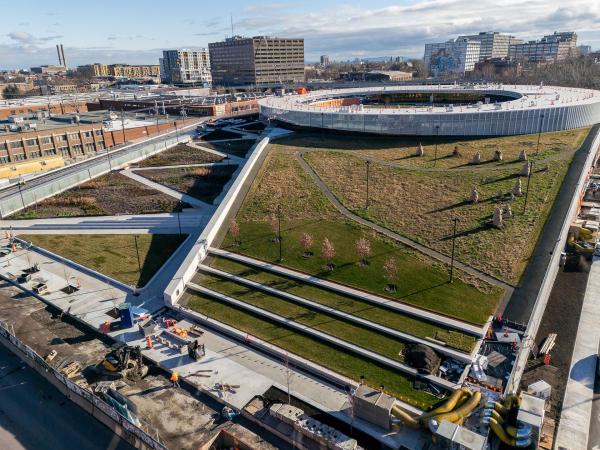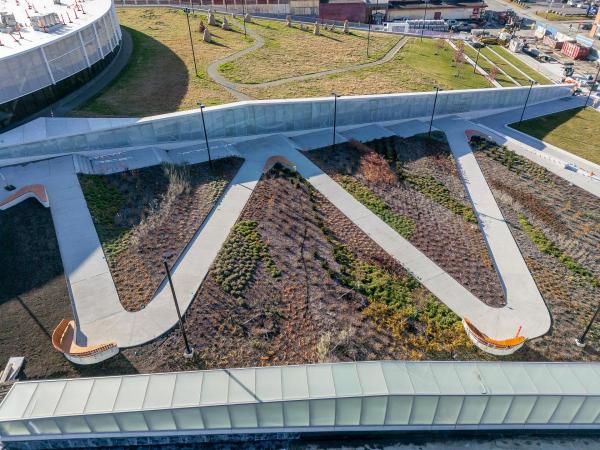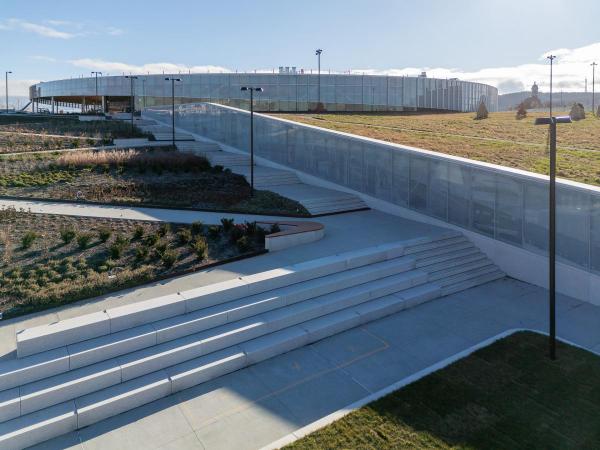Bellechasse bus garage hits major milestone
The end of the year marks an important milestone at the Bellechasse bus garage: construction is largely complete, and we’ve started gradually closing out the worksite. This allows us to reopen Bellechasse and Saint-Dominique Streets. It’s a huge project and there are still steps to complete before the complex can be commissioned, with operations scheduled to begin by fall 2025.
For now, here’s an overview of the project, which is set to help revitalize the area once it’s complete.

What the bus garage will be used for
A bus garage is where mechanics maintain and repair buses. It’s also where buses are parked overnight. It’s the starting and finishing point for bus drivers who take our customers to work, school, and many other destinations.
In total, several hundred people—bus drivers, maintenance staff and administrative personnel—will work in this complex, supporting the operation and maintenance of about 250 buses.
Building underground
To achieve seamless integration with the surrounding residential area, we chose a unique architectural design that places the entire garage structure underground. Outside, the bus garage will be covered by a green space. Buses will mostly circulate inside the building, helping to keep noise levels in the neighbourhood to a minimum. Buses will travel on the four interior ramps running from the street to the underground levels.

Green space on the roof
A new green space will be added to the neighbourhood, on the roof of the underground garage. The space already has some plants and furniture, but will get even better in the coming months. Most of the plants selected for the park are native species. More will be added in the spring, and we expect to open the green space to the public by next summer.
Bellechasse and Marmier will be connected by a pedestrian walkway leading to Rosemont métro station, further improving access to public transit in the neighbourhood.


A very green building
To meet our ambitious sustainable development goals, the building will be very environmentally friendly, with the aim of obtaining LEED Gold certification.
The building design features sources of natural light, energy efficiency measures, and a system for recycling groundwater in the areas of the Bellechasse bus garage with exposed rock. The recycled groundwater will be used to wash the buses, among other things.
Final steps
There’s still a lot of work to be done inside the building before operations begins in 2025. All of the equipment needed to run the garage, including for the heating, telecommunications, and ventilation systems, still needs to be tested and commissioned.
Some work to finalize the spaces outside the building will also continue in the spring, including resurfacing Gaspé Street and adding plants in certain areas of the green space that will be open to the public.
Learn more about the project
The Bellechasse bus garage is built on the block formed by De Gaspé Avenue and Bellechasse, Marmier and Saint-Dominique streets in Rosemont–La Petite-Patrie.
The bus garage will have two connecting structures: an underground building where the buses will be parked and maintained and a ring-shaped building with lots of windows where administrative offices and employee facilities will be located.
The garage’s operations (driving, maintenance and parking of buses, and employee parking) will be located inside the building to mitigate the impact on the neighbourhood.
There will also be a large green space partially accessible to the public.
The building will have a high-quality environmental design. We aim to obtain LEED v4 Gold certification. The complex will incorporate:
- Natural light
- Universal accessibility
- Building envelope with superior energy efficiency
- Energy efficient mechanical and heat recovery system
- Water catchment and recycling
- Recovery of construction materials, when possible
Information for local residents
During work on the Bellechasse bus garage, we discovered that the rock was not in the condition we had anticipated, despite the tests carried out before the work. This discovery meant that additional rock reconstruction and consolidation work was required to allow the construction of the building according to the planned design.
During this reconstruction and consolidation in June 2022, we detected problems with the integrity of the Berliner wall (the support wall that holds up the soil). In response, we obtained two reports from external firms to assess the situation. The reports corroborated the fact that urgent corrective work was required before the next freeze-thaw cycle, and subsequently, given the condition of the support wall system, to ensure the safety of employees and residents, as well as the sustainability of the site and infrastructure.
The work announced involves:
- Demolishing the poor-quality rock on the ledge and the rock behind the tunnel
- Applying a bituminous membrane and spraying concrete on the exposed solid rock so as to protect it
- Installing a compressible matt to absorb potential swelling of the rock (pyrite)
- Installing a protective membrane and wall to protect the rock left in place; formwork to be dropped and membrane work to be modified
- Reconstructing the ledge (formwork, reinforcement, and concrete work)
- Drilling and installing anchors adapted to each situation
A monitoring plan for the temporary support infrastructure was also quickly implemented and will be in place until the corrective work is complete. The situation at and around the worksite is stable and safe, both for people and for nearby buildings.
You can view the recording of this public information session (in French only).
Here is the list of questions asked during the virtual session and the answers that were provided.
No, the bus garage was built as planned, reaching a maximum height of 13 metres near Van Horne Viaduct. The steel structure may seem massive right now, but once the green space has been fully integrated, the bus garage will blend in well with the neighbourhood.
Unlike the first phase of the work, where a single contractor was responsible for the excavation, the current work requires contracts with about sixty contractors who, in turn, have several suppliers of their own. Please note that the general contractor’s equipment, which stays on the worksite permanently, uses a low-noise alarm to limit the noise pollution caused by the trucks when they back up.
The trucks can arrive at the worksite before 7 a.m., but the work cannot start before then. You can contact the STM about the noise and parking at 514-STM-INFO.
The studies are still ongoing.
The Bellechasse bus garage should generate less noise than the Saint-Denis bus garage, as much of the bus traffic will be inside the garage, and most of the maintenance work will be carried out underground.
No, this is not included in the project and the installation of such infrastructure is not the STM’s responsibility.
That is an interesting idea. We will have to confirm internally whether or not this is possible.
Our goal is to obtain the LEED v4 Gold Certification. To do so, we will need to demonstrate the efficiency (energy and water), sustainability (operation and maintenance), and indoor environment air quality of the electromechanical systems. To become LEED certified, we are being evaluated on how we reduce water usage, tackle urban heat islands, improve site conditions, optimize building energy performance and choose materials with a lower environmental footprint (recycled materials, etc.), among other things.
You can view the recording of this public information session (in French only).
It was necessary to make the street one-way during construction to facilitate the delivery of numerous materials, given the scope of the project. This will therefore continue until the project ends in 2022. Regarding the layout of Bellechasse Street after the work, the borough is still analyzing the best layout possible for integrating the EBN by taking our operations into consideration.
Traffic studies were conducted, and it is not a good idea to have buses on Marmier or Des Carrières streets. One of the reasons justifying our position is that buses would have to pass through residential streets east of Saint-Denis to reconnect with major roads.
We have not yet completed the detailed planning regarding bus fleet management for the coming years. We must re-evaluate our needs in light of the pandemic. One thing is certain, the Saint-Denis bus garage will no longer be a priority in terms of service once the Bellechasse bus garage is operational, particularly because it will not be equipped to house buses outfitted with the latest hybrid and electric technologies.
The Saint-Denis bus garage is slated to close in 2024, and the land will, eventually, be given to the City.
Certain vehicles will be equipped with BBS-type alarms. However, it’s difficult to make this type of alarm mandatory for the next phase of the work given the significant number of contractors and the fact that their equipment will be leased. It is important to point out that the work will be carried out at the bottom of the excavation, which will thereby limit the use of backup alarms.
We’re also studying the implementation of a traffic plan to reduce the number of times vehicles back up on the worksite, which will help reduce the noise caused by the trucks equipped with standard alarms, while increasing the safety of truck traffic.
For the time being, the bike path installations are temporary, and studies are still ongoing. The final installations will be made once our work is completed, in collaboration with the borough, which is responsible for bike paths and traffic.
It is prohibited to use cross-streets since they aren’t truck routes. If you notice an increase in truck traffic on the cross-streets, we urge you to notify us of it through our customer service, so that we may notify the contractor.
During construction, there may be obstructions in the dog park at certain times. However, the dog park will be maintained after the construction of the bus garage.
The buses will enter and exit by De Gaspé Street before reconnecting with Bellechasse. Secondary exits and entrances are being planned on Saint-Dominique Street, in the event of an emergency or major obstruction on De Gaspé Street.
The plan is to install street furniture, such as picnic tables, garbage cans and benches. We’re also planning to install stands should public events be held.
Numerous construction projects in the area during 2020 have had an impact on traffic flow. Among them are the OMHM’s worksite at the Rosemont Métro station, the construction work on the Rosemont/Van Horne Viaduct, the refurbishment project of Plaza Saint-Hubert, and the installation work for the Saint-Denis EBN. We were united with our partners in setting up mitigation measures to reduce the impact of this work on our bus service.
As well, during 2021, we will continue to follow the development of the bus service operating conditions, in light of the creation of the Saint-Denis EBN, and make any modifications that may be required.
During construction, there may be obstructions in the dog park at certain times. However, the dog park will be maintained after the construction of the bus garage.
- De Gaspé Street is closed along the worksite, between De Bellechasse and Marmier. Buildings, including BIXI, will remain accessible through the parking lot next to BIXI and at other points.
- The dog park remains accessible.
Inquiries are processed on a case by case basis. To make an inquiry, you must contact our customer service and submit an official complaint. A claim file will be opened with the contractor’s insurer.
We can make vibration data public. To access it, you can make an access to information request to the STM.
As for air quality data, we do not produce any. Air quality is monitored on the spot when workers return to the site after blasting.
There is less dust in winter, and we are evaluating which dust management method to use.
During the construction, the contractor is responsible for planning and managing parking for workers so that maximum parking is available for local residents.Most of the workers park on the worksite.
We have a traffic plan that was approved by the borough, and truck drivers have been informed of the truck routes to use. We are working with the borough and the SPVM to ensure that trucks use the approved routes. We are monitoring this closely to ensure that the instructions given are followed and that trucks do not take residential streets.
In general, the work will take place from Monday to Friday, 7 a.m. to 7 p.m. It can, however, take place on the weekend in accordance with municipal by-laws. To view the borough’s by-law, click here (in French only).
Due to a lack of participation, the good neighbourhood committee will not continue its activities. However, information sessions may be held during the project.
Once the construction is complete, there will be underground parking spaces for employees working at the new garage.
- We have introduced a traffic maintenance plan, established by a specialized firm, for motorists, pedestrians and cyclists in the area.
- An inspector will be on the worksite to ensure compliance with regulations on noise levels and work hours.
- Water spraying will be carried out during demolition and excavation to reduce dust.
- The metal fences surrounding the worksite have been replaced by wooden partitions. The partitions have been installed on three streets: Saint-Dominique, Bellechasse and De Gaspé.
We are aware of the inconvenience that this work might cause. Rest assured that we will do what is necessary to minimize the impact on our customers.
Stay informed
Stay informed of the project’s progress and other events by signing up for the electronic newsletter.
This work is made possible by funding provided by the Ministère des Transports du Québec and Infrastructure Canada.
